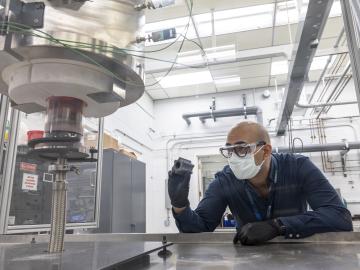
Filter News
Area of Research
- Advanced Manufacturing (11)
- Biology and Environment (29)
- Computer Science (4)
- Electricity and Smart Grid (2)
- Energy Science (87)
- Functional Materials for Energy (1)
- Fusion and Fission (5)
- Materials (44)
- Materials for Computing (7)
- National Security (20)
- Neutron Science (17)
- Nuclear Science and Technology (5)
- Quantum information Science (6)
- Supercomputing (53)
News Type
News Topics
- (-) 3-D Printing/Advanced Manufacturing (110)
- (-) Big Data (57)
- (-) Clean Water (18)
- (-) Grid (50)
- (-) Machine Learning (51)
- (-) Molten Salt (5)
- (-) Polymers (23)
- (-) Quantum Science (81)
- Advanced Reactors (26)
- Artificial Intelligence (114)
- Bioenergy (94)
- Biology (106)
- Biomedical (60)
- Biotechnology (35)
- Buildings (49)
- Chemical Sciences (72)
- Composites (24)
- Computer Science (178)
- Coronavirus (36)
- Critical Materials (16)
- Cybersecurity (32)
- Education (5)
- Element Discovery (1)
- Emergency (3)
- Energy Storage (77)
- Environment (162)
- Exascale Computing (66)
- Fossil Energy (7)
- Frontier (62)
- Fusion (56)
- High-Performance Computing (117)
- Hydropower (6)
- Irradiation (1)
- Isotopes (55)
- ITER (6)
- Materials (119)
- Materials Science (115)
- Mathematics (8)
- Mercury (9)
- Microelectronics (4)
- Microscopy (41)
- Nanotechnology (48)
- National Security (80)
- Neutron Science (141)
- Nuclear Energy (98)
- Partnerships (67)
- Physics (60)
- Quantum Computing (49)
- Security (28)
- Simulation (54)
- Software (1)
- Space Exploration (16)
- Statistics (3)
- Summit (63)
- Transportation (62)
Media Contacts

A rapidly emerging consensus in the scientific community predicts the future will be defined by humanity’s ability to exploit the laws of quantum mechanics.

Researchers at ORNL used polymer chemistry to transform a common household plastic into a reusable adhesive with a rare combination of strength and ductility, making it one of the toughest materials ever reported.

A novel method to 3D print components for nuclear reactors, developed by the Department of Energy’s Oak Ridge National Laboratory, has been licensed by Ultra Safe Nuclear Corporation.

A team of scientists led by the Department of Energy’s Oak Ridge National Laboratory and the Georgia Institute of Technology is using supercomputing and revolutionary deep learning tools to predict the structures and roles of thousands of proteins with unknown functions.

ORNL and Tuskegee University have formed a partnership to develop new biodegradable materials for use in buildings, transportation and biomedical applications.

Energy Secretary Jennifer Granholm visited ORNL on Nov. 22 for a two-hour tour, meeting top scientists and engineers as they highlighted projects and world-leading capabilities that address some of the country’s most complex research and technical challenges.

Ten scientists from the Department of Energy’s Oak Ridge National Laboratory are among the world’s most highly cited researchers, according to a bibliometric analysis conducted by the scientific publication analytics firm Clarivate.

Researchers at ORNL designed a novel polymer to bind and strengthen silica sand for binder jet additive manufacturing, a 3D-printing method used by industries for prototyping and part production.

Amy Elliott, a group leader for robotics and intelligent systems at Oak Ridge National Laboratory, has received the 2021 ASTM International Additive Manufacturing Young Professional Award for her early career research contributions

A team led by the U.S. Department of Energy’s Oak Ridge National Laboratory demonstrated the viability of a “quantum entanglement witness” capable of proving the presence of entanglement between magnetic particles, or spins, in a quantum material.


